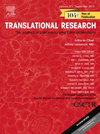2021年最新SCI期刊影响因子查询系统
Translational Research 期刊详细信息
基本信息
|
期刊名称

|
Translational Research TRANSL RES |
|---|---|
| 期刊ISSN | 1931-5244 |
| 期刊E-ISSN | 1878-1810 |
|
2023-2024最新影响因子
(数据来源于搜索引擎)
|
6.4 |
| 最新影响因子 | 截止2024年3月26日:6.175 |
| 五年影响因子 | |
| JCI期刊引文指标 | 2.17 |
| 期刊官方网站 | http://www.translationalres.com/ |
| 是否OA | |
| 出版商 | Mosby Inc. |
| 出版周期 | Monthly |
| 始发年份 | 2006 |
| 年文章数 | 96 |
| Gold OA文章占比 | 34.15% |
|
研究类文章占比:
文章 ÷(文章 + 综述)
|
80.21% |
| 收稿范围 | UNITED STATES |
| 期刊投稿网址 | https://www.editorialmanager.com/TRANSRES |
CiteScore
| CiteScore | SJR | SNIP | CiteScore排名 | ||||||||||||||||
|---|---|---|---|---|---|---|---|---|---|---|---|---|---|---|---|---|---|---|---|
| 15.70 | 1.913 | 1.327 |
|
WOS期刊SCI分区 (2023-2024年最新版)
| 按JIF指标学科分区 | 收录子集 | JIF分区 | JIF排名 | JIF百分位 |
| 学科:MEDICAL LABORATORY TECHNOLOGY | SCIE | Q1 | 3/30 |
|
| 学科:MEDICINE, GENERAL & INTERNAL | SCIE | Q1 | 27/325 |
|
| 学科:MEDICINE, RESEARCH & EXPERIMENTAL | SCIE | Q1 | 26/189 |
|
| 按JCI指标学科分区 | 收录子集 | JCI分区 | JCI排名 | JCI百分位 |
| 学科:MEDICAL LABORATORY TECHNOLOGY | SCIE | Q1 | 2/30 |
|
| 学科:MEDICINE, GENERAL & INTERNAL | SCIE | Q1 | 16/329 |
|
| 学科:MEDICINE, RESEARCH & EXPERIMENTAL | SCIE | Q1 | 12/189 |
|
中国科学院SCI期刊分区(2023年12月最新升级版)
| 大类学科 | 小类学科 | Top期刊 | 综述期刊 | ||||||
|---|---|---|---|---|---|---|---|---|---|
| 医学 2区 |
| 否 | 否 |
中国科学院SCI期刊分区(2022年12月升级版)
| 大类学科 | 小类学科 | Top期刊 | 综述期刊 | ||||||
|---|---|---|---|---|---|---|---|---|---|
| 医学 2区 |
| 否 | 否 |
中国科学院SCI期刊分区(2021年12月旧的升级版)
| 大类学科 | 小类学科 | Top期刊 | 综述期刊 | ||||||
|---|---|---|---|---|---|---|---|---|---|
| 医学 2区 |
| 是 | 否 |
补充信息
| 2023-2024自引率 | 0.00% | |
|---|---|---|
| H-index | 86 | |
| SCI收录状况 | Science Citation Index Expanded (SCIE) (2020年1月,原SCI撤销合并入SCIE,统称SCIE) Scopus (CiteScore) |
|
| 官方审稿时间 | 较慢,6-12周 |
|
| 网友分享审稿时间 | ||
| PubMed Central (PML) | http://www.ncbi.nlm.nih.gov/nlmcatalog?term=1931-5244%5BISSN%5D | |








